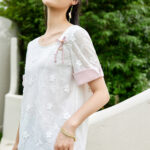Jacquard Dress Elegance: Timeless Style for Every Occasion
In the world of fashion, few garments blend artistry, heritage, and versatility as seamlessly as the jacquard dress. From red-carpet events to casual brunches, this piece transcends trends, offering a timeless elegance rooted in meticulous craftsmanship. Unlike mass-produced fast fashion, a jacquard weave tells a story through its intricate patterns, each thread woven with precision. Whether you’re seeking a statement piece for a wedding or a sophisticated office ensemble, the jacquard dress adapts effortlessly, marrying tradition with modern flair. Let’s explore why this garment deserves a prime spot in your wardrobe, backed by history, science, and the voices of style authorities.
The Art and Science of Jacquard Weaving
Jacquard weaving isn’t merely a technique; it’s a revolution in textile production that dates back to the early 19th century. Invented by Joseph Marie Jacquard in 1804, the Jacquard loom introduced a punch-card system that automated complex pattern weaving, a precursor to modern computing. According to Wikipedia, this innovation allowed for “unprecedented complexity in designs,” enabling fabrics with elaborate motifs like florals, geometrics, or damasks without manual intervention. Scientifically, the process involves raising and lowering individual warp threads to create raised patterns that are integral to the fabric, not printed on. This results in a durable, textured material that resists fading and wear. As the Metropolitan Museum of Art notes, jacquard textiles became synonymous with luxury, adorning European aristocracy. Today, this method produces everything from brocades to tapestries, but the jacquard dress stands out for its wearable art quality. The patterns aren’t just decorative; they reflect a heritage of innovation, making each piece a conversation starter. When you slip into a jacquard dress, you’re wearing a piece of history engineered for contemporary life.
Versatility Across Occasions: From Day to Night
One of the most compelling attributes of the jacquard dress is its chameleon-like ability to suit diverse settings. For daytime events, such as garden parties or brunches, a knee-length jacquard shift dress in subtle tones exudes understated chic. The texture adds depth without overwhelming, pairing perfectly with sandals or flats. As fashion icon Iris Apfel once remarked, “Style is about expressing yourself, and jacquard does that with elegance and fun.” Transition to evening, and a floor-length jacquard gown commands attention at galas or weddings. The interplay of light on the raised patterns creates a dynamic visual effect, eliminating the need for excessive accessories. Websites like Vogue and Harper’s Bazaar frequently highlight jacquard as a “fall favorite” for its warmth and richness, but its breathability—thanks to natural fibers like cotton or silk blends—makes it year-round versatile. In corporate settings, a tailored jacquard sheath dress projects professionalism with a creative twist, aligning with Forbes’ advice on “power dressing with personality.” Ultimately, this adaptability stems from the fabric’s inherent balance of structure and fluidity, allowing it to mold to various silhouettes and styles.
Expert Insights and Cultural Resonance
Authority figures across industries champion jacquard for its blend of aesthetics and substance. On Quora, textile engineers emphasize that “jacquard weaves are superior in durability due to the interlocked threads,” which prevent pattern distortion over time. Historically, figures like Coco Chanel incorporated jacquard into their designs to democratize luxury, a tradition continued by modern brands like Gucci and Dolce & Gabbana. In literature, F. Scott Fitzgerald’s “The Great Gatsby” evokes the opulence of the Jazz Age through descriptions of jacquard-like fabrics, symbolizing wealth and artistry. From academia, the Fashion Institute of Technology’s curriculum highlights jacquard as a “cornerstone of textile education,” underscoring its technical and creative significance. On social media, YouTube stylists like Alexa Chung advocate for jacquard as a “timeless investment,” noting its resale value on platforms like The RealReal. Even Baidu Baike and Wenku entries detail its global influence, from Chinese silk jacquards to European adaptations. These perspectives converge on one point: a jacquard dress isn’t just clothing; it’s a culturally validated masterpiece that bridges past and present.
Curating Your Collection: Tips and Discount Opportunities
Building a wardrobe with jacquard pieces requires thoughtfulness, but the rewards are immense. Start with a neutral-hued dress—think navy, black, or ivory—that can be accessorized for multiple events. Look for blends incorporating wool for winter or linen for summer, ensuring comfort. Brands like Reformation and Boden often feature jacquard designs at accessible price points, especially during seasonal sales. For instance, end-of-season discounts can slash prices by 30-50%, making high-quality jacquard attainable. Subscribe to newsletters from retailers like Nordstrom or Net-a-Porter for exclusive offers; Black Friday and Christmas sales are prime times to invest. Remember, proper care—dry cleaning or gentle hand-washing—preserves the intricate patterns for years. As you explore, consider custom options from platforms like Etsy, where artisans offer unique jacquard creations. The goal is to prioritize craftsmanship over quantity; one exquisite jacquard dress outshines a closet of disposable fashion. Embrace it as a lifelong companion in style.
In essence, the jacquard dress embodies more than aesthetic appeal; it represents a fusion of innovation, history, and practicality. Its ability to elevate any occasion, backed by authoritative endorsements and scientific resilience, makes it a indispensable choice. Invest in this timeless piece, and you’ll discover a garment that grows with you, always ready to impress.






